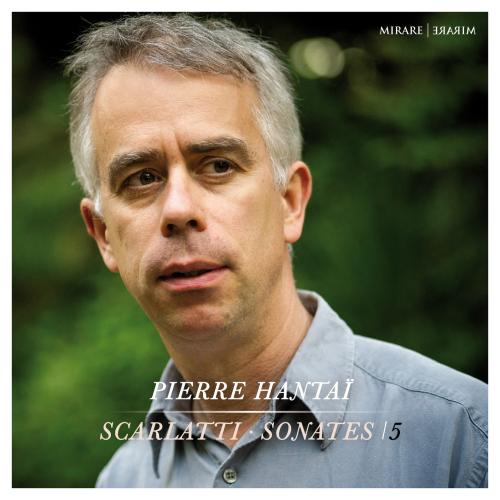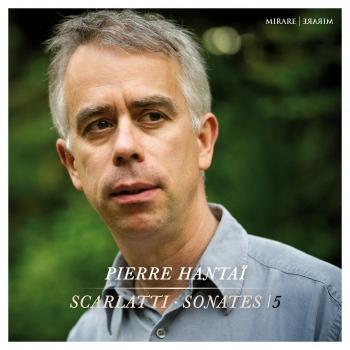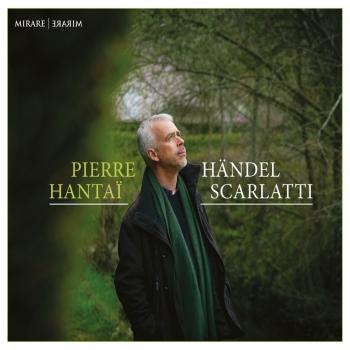
Scarlatti 5 Pierre Hantai
Album info
Album-Release:
2017
HRA-Release:
05.05.2017
Label: Mirare
Genre: Classical
Subgenre: Instrumental
Artist: Pierre Hantai
Composer: Domenico Scarlatti (1685-1757)
Album including Album cover Booklet (PDF)
- Domenico Scarlatti (1685 - 1757): Keyboard Sonatas:
- 1 Keyboard Sonata in B-Flat Major, K. 551: Allegro 04:12
- 2 Keyboard Sonata in E-Flat Major, K. 474: Andante e cantabile 06:56
- 3 Keyboard Sonata in E-Flat Major, K. 475: Allegrissimo 03:57
- 4 Keyboard Sonata in E-Flat Major, K. 252: Allegro 04:11
- 5 Keyboard Sonata in E-Flat Major, K. 253: Allegro 03:05
- 6 Keyboard Sonata in G Major, K. 547: Allegro 04:31
- 7 Keyboard Sonata in B Minor, K. 87: (Andante) 05:34
- 8 Keyboard Sonata in E Major, K. 28: Presto 04:14
- 9 Keyboard Sonata in A Major, K. 211: Andantino 07:31
- 10 Keyboard Sonata in D Major, K. 401: Allegro 03:37
- 11 Keyboard Sonata in D Major, K. 388: Presto 04:06
- 12 Keyboard Sonata in D Major, K. 277: Cantabile andantino 04:45
- 13 Keyboard Sonata in G Major, K. 124: Allegro 05:11
- 14 Keyboard Sonata in C Major, K. 157: Allegro 03:16
- 15 Keyboard Sonata in F Minor, K. 238: Andante 04:22
- 16 Keyboard Sonata in F Major, K. 205: Vivo 08:46
Info for Scarlatti 5
Viewed from a distance, the corpus of the ‘555’ keyboard sonatas of Domenico Scarlatti seem like a juggernaut as improbable as it is unsettling. Its dimensions impress, its nature intrigues. Virtually all of these sonatas, written throughout the composer’s life, employ the same mould: a single movement in binary form, very occasionally differentiated from its fellows by the name of a dance or an indication of affect, never by a title. There is also the often acrobatic instrumental technique they require, and their style of writing, austere, irregular, noisy and contrasted, which can easily bewilder even the most seasoned interpreters. One understands why the Kirkpatrick catalogue arranges things so as to attain the memorable total of ‘555’: it is necessary, at whatever cost, to humanise this gigantic non-monument.
Like many celebrated musicians, Scarlatti was himself the son of a musician. Having quickly attracted attention for his abilities in composition and at the harpsichord, the ‘eagle’ left Naples to ‘take flight’ in Venice (1705-09), then in Rome. Notable among those he met there were Gasparini, Weiss, Roseingrave, Handel, and certainly also Vivaldi, a close associate of Gasparini in Venice. In 1719, when he was in Rome, he is said to have been invited to London to conduct his opera Narciso; but no document con rms whether the trip actually occurred. In that same year his life took on a decisive turn: he accepted the post of music director of the Patriarchal Basilica in Lisbon. Since the city did not have an opera season, he devoted himself almost exclusively to composing for the keyboard. He then became the teacher of the young Seixas and of the brother and daughter of King João V, Don Antonio and Maria Bárbara de Bragança (then eight years old); the princess quickly became one of the most distinguished exponents of his music. During his early years in Portugal, Scarlatti returned to Italy several times and also made a journey to France (1724-25) which may eventually have led to the publication of his famous Essercizi (c.1737/1738). ….
Pierre Hantaï, harpsichord
Pierre Hantaï
Born in 1964, Pierre Hantaï became passionately devoted to the music of Bach around the age of ten. Thanks to the influence of Gustav Leonhardt, he began to study the harpsichord, alone at first, then guided by the American teacher Arthur Haas. He gave his first concerts at an early age, alone or with his brothers Marc and Jérôme. He then spent two years studying in Amsterdam with Gustav Leonhardt, who subsequently invited him to perform under his direction.
In the years that followed he collaborated with many musicians and directors of Baroque ensembles, among them Philippe Herreweghe, the Kuijken brothers, François Fernandez, Marc Minkowski and Philippe Pierlot. Nowadays he mostly performs as a soloist around the world. He often appears as a guest with Jordi Savall, and he also enjoys joining his brothers and such friends as Hugo Reyne, Sébastien Marq, Amandine Beyer, Skip Sempé, Olivier Fortin, Christophe Coin and Jean-Guihen Queyras to play chamber music.
He recently re-formed the ensemble he created in the 1980s, Le Concert Français, for several concerts and a disc of suites and cantatas by Bach. His extensive discography includes a number of recordings for Mirare: Bach’s Well-Tempered Clavier (Book I), Goldberg Variations, and ute sonatas (with Hugo Reyne); four discs of sonatas by Domenico Scarlatti; a programme of works by François Couperin; and a recording of music for two harpsichords by Rameau (with Skip Sempé).
Booklet for Scarlatti 5










